| Monday, February 17, 2003 |  |
|
|
|
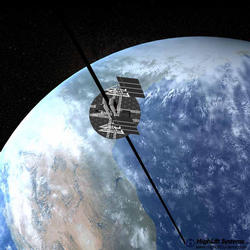 Some news about Highlift Systems who are planning on building elevators to geostationary orbit. They may have found a second location for the anchor of their space elevator - Perth, Western Australia, which apparently has the calm waters and international airport needed. The whole project has apparently gotten more momentum after the shuttle disaster. And with a startup cost of 7-10 billion, it will need a lot more support. Some news about Highlift Systems who are planning on building elevators to geostationary orbit. They may have found a second location for the anchor of their space elevator - Perth, Western Australia, which apparently has the calm waters and international airport needed. The whole project has apparently gotten more momentum after the shuttle disaster. And with a startup cost of 7-10 billion, it will need a lot more support. It would act like the cable in the centre of a lift, with lift cars which could take people into space and back. The earth end of the ribbon would be connected to a terminal floating on the ocean about 100km off the coast which would use Perth Airport as an international contact point. Each lift car would be able to carry up to six people, with luggage and air supply. Travellers would be taken as a first step 100,000km into space to a space station. The station could be connected to more ribbons for journeys on to the moon or beyond. It might potentially reduce launch costs from the current $10-40,000 per kilogram to $100 per kilogram.
[ Technology | 2003-02-17 23:59 | | PermaLink ] More >
|
|
| Wednesday, February 12, 2003 |  |
|
|
|
 My e-mail program is a constant element of annoyance in my life, because it doesn't do the things I'd need it to do, and I get way too much mail for it to work right. It is Eudora 5.2, which is a fine e-mail program as it goes, but I need a whole other level of functionality. These are things I need: My e-mail program is a constant element of annoyance in my life, because it doesn't do the things I'd need it to do, and I get way too much mail for it to work right. It is Eudora 5.2, which is a fine e-mail program as it goes, but I need a whole other level of functionality. These are things I need:
- I need to keep track of my correspondence with different people. It should be easy to immediately see all prior incoming and outgoing messages in chronological order between me and a certain other person.
- I shouldn't have to create special mailboxes and filters to do that.
- Some people have several e-mail addresses, and I might have several e-mail addresses. I still want to be able to see my conversations with one person in one place, no matter what address we used, and no matter how we spelled our name that day.
- When I get a message, my e-mail program should know whether this is somebody I know or not. Certainly it should know right away whether it is somebody I've ever exchanged e-mails with, and it should tell me somehow.
- It should preferably also know if it is a known member of some group I'm in. There are 7000 people in the NCN directory. I'd like my e-mail program to recognize one of those people if they write to me, even if we didn't exchange e-mail before.
- I'd like my e-mail program to have a reasonable assurance that an e-mail really is from the person it says it is. The SMTP protocol allows anybody to enter whatever they like as sender, so I need some kind of ID mechanism built in here.
- I need SPAM recognition that I can train, like Apple's Mail program. I don't want centralized anti-SPAM blacklists, because they work badly and block things that shouldn't be blocked.
- Any message that isn't from somebody I probably know, and that doesn't have proper digital ID, should go into a totally different place than messages that are from real people.
- I need to be able to put a given message into any number of folders at the same time, without creating several copies. I need more dimensions. I want to always remember that a certain message was sent or received, so in principle it shouldn't actually leave my outbox or inbox, but at the same time I might want to file it under several different subjects, and give it various flags, and find it according to any of those keys.
- I want statistics. How many messages do I get per day, how many did I answer, how many did I send, etc.
None of those things are overly hard. Hardest part is probably the digital ID. The rest I could probably program myself, if I had a few weeks with nothing else to do, which isn't very likely. I need similar things for my Instant Messager programs. Actually I want continuity in my conversations across several different applications and platforms. Has anybody solved these things well in a program I don't know about?
[ Technology | 2003-02-12 18:01 | 0 comments | PermaLink ]
|
|
| Monday, February 10, 2003 |  |
|
|
|
I believe that sooner or later we'll be switching over to totally different energy production devices. Not burning old dinosaurs, but rather drawing a charge from the quantum field, or something along those lines. And there has been no lack of people who seemed to have invented over-unity devices. But either somebody managed to buy off or murder ALL of them, or they didn't really work when put under scrutiny. So it is with some caution that I pass on news about 'free' energy devices. But Stephen Greer of the Disclosure Project has his head screwed on fairly well, and even though he likes being the center of attention, what he presents is normally very solid. A while back he set up a company, Space Energy Access Systems, for the purpose of locating and marketing such devices. And he believes he has something now. See transcript of an interview."It's not very big at all. I picked it up - you can pick it up with one hand. Took it out actually on a sidewalk. This device gathered, very passively, less than one watt of power from the environment - I won't say how it was done, I'm not allowed to at this point - and the machine started up. It generated hundreds of watts of power in usable form. We hooked this up ourselves, so there was no mystery about it. We even selected the things to hook up to this thing. It ran a 300-watt light bulb, a 100-watt light bulb, a stereo and an oscillating fan with an electric motor, all at the same time with literally no artificial manmade input of power." I hope it stands up to further scrutiny. Getting rid of the oil economy would change everything.
[ Technology | 2003-02-10 23:05 | | PermaLink ] More >
|
|
| Thursday, February 6, 2003 |  |
|
|
|
 It seems to be just a demo, but apparently Japanese scientists are working on ways of making camouflaged objects transparent. The principle is basically to record video images behind someone or something, and then projecting it or displaying it in front. Just like the U.S. military is planning to invent NanoPaint that can cover vehicles and make them invisible. It seems to be just a demo, but apparently Japanese scientists are working on ways of making camouflaged objects transparent. The principle is basically to record video images behind someone or something, and then projecting it or displaying it in front. Just like the U.S. military is planning to invent NanoPaint that can cover vehicles and make them invisible.
[ Technology | 2003-02-06 17:45 | 0 comments | PermaLink ]
|
|
| Sunday, February 2, 2003 |  |
|
|
|
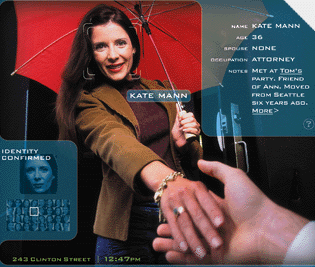 Ross Mayfield mentions some interesting thoughts and scenarios concerning augmented reality (e.g. heads up displays showing you information about what you're looking at) converging with moblogging (weblogging via mobile phone type devices). Ross Mayfield mentions some interesting thoughts and scenarios concerning augmented reality (e.g. heads up displays showing you information about what you're looking at) converging with moblogging (weblogging via mobile phone type devices).AR TOMORROW: RECOGNIZING FACES
Ever forget a face? Augmented reality will help you recover seamlessly when you bump into some-one and can't remember whether she's a college acquaintance or your accountant's ex-wife. Your AR system will automati-cally search a personalized face-recognition database, then provide text that tells you not only the name of the person you're looking at, but some key personal details as well. I could sure use one of those. But it is also a bit of a freaky thought.
[ Technology | 2003-02-02 23:37 | 0 comments | PermaLink ]
|
|
| Saturday, January 25, 2003 |  |
|
|
|
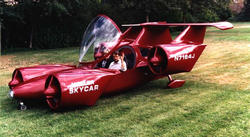 If you'd rather commute to work through the air in a flying car, then you can bid on a prototype of the Moller SkyCar on eBay. I mentioned the SkyCar last here. It sounds very promising, but they're progressing somewhat cautiously. The model that will be for sale is potentially flyable, but has only been used for tethered test flights. They still hope for production within a few years, and the idea is that it could fit pretty much in a normal parking space, and it can take off vertically and fly at 300MPH, and it would be computer guided and very resilient to failures. They hope it would cost around $50K. If you'd rather commute to work through the air in a flying car, then you can bid on a prototype of the Moller SkyCar on eBay. I mentioned the SkyCar last here. It sounds very promising, but they're progressing somewhat cautiously. The model that will be for sale is potentially flyable, but has only been used for tethered test flights. They still hope for production within a few years, and the idea is that it could fit pretty much in a normal parking space, and it can take off vertically and fly at 300MPH, and it would be computer guided and very resilient to failures. They hope it would cost around $50K.
[ Technology | 2003-01-25 23:59 | | PermaLink ] More >
|
|
|
|
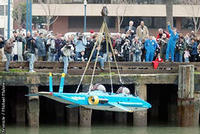 Yesterday there was a demonstration of an innovative personal submarine in the San Francisco Bay. It is meant to move through the water more like a glider or a jet than a traditional submarine. It is a homemade craft built by a local. Yesterday there was a demonstration of an innovative personal submarine in the San Francisco Bay. It is meant to move through the water more like a glider or a jet than a traditional submarine. It is a homemade craft built by a local.
[ Technology | 2003-01-25 23:52 | 0 comments | PermaLink ]
|
|
| Friday, January 24, 2003 |  |
|
|
|
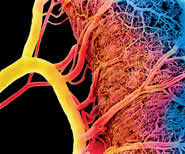 New Scientist reports that scientists have some success with using modified desktop printers to 'print' three-dimensional structures out of living cell tissue. Sounds crazy, but they say it is a step towards creating blood vessels or whole organs that way. Part of the magic comes from the observation that bits of tissue placed next to each other naturally will fuse together. So, if they're small enough, and close enough, they'll stick together. And ink-jet printers are about spewing out little blobs of stuff that are really close to each other. New Scientist reports that scientists have some success with using modified desktop printers to 'print' three-dimensional structures out of living cell tissue. Sounds crazy, but they say it is a step towards creating blood vessels or whole organs that way. Part of the magic comes from the observation that bits of tissue placed next to each other naturally will fuse together. So, if they're small enough, and close enough, they'll stick together. And ink-jet printers are about spewing out little blobs of stuff that are really close to each other.
[ Technology | 2003-01-24 23:59 | 0 comments | PermaLink ]
|
|
| Thursday, January 23, 2003 |  |
|
|
|
 SpaceDaily has an article about technologies used by participants in the 2003 Paris-Dakar rally. Thermal screens under the car, cooling system in your helmet, self-cooling containers, and space-food to eat. SpaceDaily has an article about technologies used by participants in the 2003 Paris-Dakar rally. Thermal screens under the car, cooling system in your helmet, self-cooling containers, and space-food to eat.
[ Technology | 2003-01-23 23:45 | | PermaLink ] More >
|
|
|
|
New Scientist says that the port of Rotterdam is working on a system for docking ships using magnets. Apparently it would save a good deal of time, effort and money if one can just flick a switch to pull a ship into a secure position, rather than maneuvering around with ropes.
[ Technology | 2003-01-23 23:45 | 0 comments | PermaLink ]
|
|
|
|
According to New Scientist, American engineers in the Antarctic have begun work on a highway from the giant US coastal base at McMurdo Sound to the South Pole - a distance of 1600 kilometers. An initial purpose for the highway will be to help lay a $250-million fibre-optic cable to the Scott-Amundsen base. The Scott-Amundsen base is home to a growing amount of scientific equipment. But it is out of sight of most geostationary communications satellites, so it cannot reliably send back real-time data to the laboratories in the US that use the equipment. The cable would solve that problem.
[ Technology | 2003-01-23 23:45 | | PermaLink ] More >
|
|
| Wednesday, January 22, 2003 |  |
|
|
|
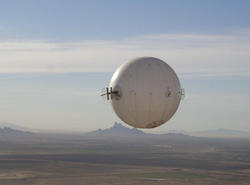 21st Century Airships apparently has a contract to build replacements for cellphone towers for several US companies, in the form of balloons, permanently anchored up in the air. They're still working on developing 'High Altitude Platforms' which would be stationed even higher, in the stratosphere 18-21km above earth, to serve other telecommunications needs, and environmental monitoring. 21st Century Airships apparently has a contract to build replacements for cellphone towers for several US companies, in the form of balloons, permanently anchored up in the air. They're still working on developing 'High Altitude Platforms' which would be stationed even higher, in the stratosphere 18-21km above earth, to serve other telecommunications needs, and environmental monitoring.
[ Technology | 2003-01-22 23:59 | | PermaLink ] More >
|
|
| Monday, January 20, 2003 |  |
|
|
|
 HeadMap is a site, a magazine and a collective focusing on examining the social implications and applications of location aware devices. Cool, cool things. You know, along the lines of wearable computers that know where you are, and that know things about the local environment, and that can connect you with others who are around. HeadMap is a site, a magazine and a collective focusing on examining the social implications and applications of location aware devices. Cool, cool things. You know, along the lines of wearable computers that know where you are, and that know things about the local environment, and that can connect you with others who are around.there are notes in boxes that are empty
every room has an accessible history
every place has emotional attachments you can open and save
you can search for sadness in new york
people within a mile of each other who have never met stop what they are doing and organise spontaneously to help with some task or other.
in a strange town you knock on the door of someone you don’t know and they give you sandwiches.
paths compete to offer themselves to you
life flows into inanimate objects
the trees hum advertising jingles
everything in the world, animate and inanimate, abstract and concrete, has thoughts attached
[ Technology | 2003-01-20 19:10 | | PermaLink ] More >
|
|
| Sunday, January 19, 2003 |  |
|
|
|
Engineers at BASF present some promising new uses of nanotechnology that appear to be just around the corner. Toothpaste that actually rebuilds the enamel on your teeth, shoes that dirt just can't stick to, and batteries as sponges for hydrogen.
[ Technology | 2003-01-19 23:59 | 0 comments | PermaLink ]
|
|
| Saturday, January 18, 2003 |  |
|
|
|

Steet Sensation shows contiguous photos of shops and bars and restaurants on a bunch of the busiest streets in London. Seamless City in San Francisco does it apparently even better, with a 30 mile seamless path of photos. It would be interesting if that kind of thing were easily accessible online, for many different cities, so that you can do a virtual tour of different areas. Would be even better if it were live, of course.
[ Technology | 2003-01-18 21:40 | 0 comments | PermaLink ]
|
|
| Thursday, January 16, 2003 |  |
|
|
|
Some engineers and surgeons in Singapore have developed a robot that can do brain surgery. Well, specifically it would be able to drill through the bone of the skull faster and more precisely than humans are able to. It runs on the Linux platform, which is no surprise. But now, I think that anybody who works for Microsoft should be forced to have their brain surgery done by a program running on Windows. That would be cruel, but very fair. Gives a new meaning to the Blue Screen of Death.
[ Technology | 2003-01-16 18:10 | | PermaLink ] More >
|
|
| Wednesday, January 15, 2003 |  |
|
|
|
Computerworld: On flight LH 418 from Frankfurt to Washington, Lufthansa AG today began a three-month trial of a new onboard wireless broadband service that allows travelers to connect to the Internet some 30,000 feet in the sky... Users will be able to download from the Internet at speeds up to 3M bit/sec. and upload, initially, at speeds up to 128K bit/sec., according to Lufthansa. The upload speeds will later increase to 750K bit/sec.... Cisco Systems Inc. is providing technology for the onboard 802.11b-based network, which offers wireless connectivity throughout all cabins, in addition to wireline connectivity via an Ethernet connector in the passenger seats. That would be nice. Seems like such a waste a time to just sit and doze off in planes. So, now, if we could just make the people in front of me not lean back their seats ...
[ Technology | 2003-01-15 23:59 | 0 comments | PermaLink ]
|
|
| Monday, January 13, 2003 |  |
|
|
|
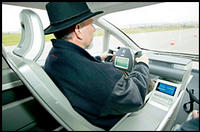 The GM Hy-Wire drive-by-wire fuel-cell prototype car is reviewed at AutoWeek. You know, it is basically just an 11 inch platform with all the essentials inside, and with four wheels, and the rest can be arranged any which way on top, which gives a lot of freedom for the designers. Its all great except for that it is really expensive. Around 10 times the cost of a normal car. The GM Hy-Wire drive-by-wire fuel-cell prototype car is reviewed at AutoWeek. You know, it is basically just an 11 inch platform with all the essentials inside, and with four wheels, and the rest can be arranged any which way on top, which gives a lot of freedom for the designers. Its all great except for that it is really expensive. Around 10 times the cost of a normal car.
[ Technology | 2003-01-13 17:01 | 0 comments | PermaLink ]
|
|
| Saturday, January 11, 2003 |  |
|
|
|
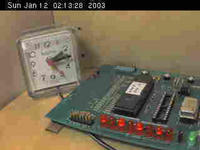 A posting on SmartMobs talks about the possibility of controlling stuff over the net. A posting on SmartMobs talks about the possibility of controlling stuff over the net."We've all heard a lot about Internet Appliances (IA). But how many of you have actually experienced the thrill of commanding an appliance over the internet?
Well, this is your big chance to actually play with something of that kind..." And you can do a little actual experiment here. But now, this is one of the things that is puzzling, that this stuff isn't ubiquitous by now. 20-25 years ago when people were soldering together the first micro computers, this was one of the first thoughts. Many computer amateurs were electronic buffs, like myself. Using your new computer to control relays that would turn on the light or draw the curtains according to some clever program - that would be one of the very first cool things you'd want to do. And there were boards and kits available for that, and diagrams in the Ciarcia's Circuit Cellar columns in Byte (a leading computer magazine at the time) on how to do it. But I suppose all the electronics buffs converted to being software people, and they got lost in something else. I for one would enjoy being able to control stuff in my house from my cellphone while I'm traveling. It can be done, with stuff like X10 devices (which I'm not going to link to, because I hate their annoying popup ads), but it is not much easier than 20 years ago.
[ Technology | 2003-01-11 18:14 | | PermaLink ] More >
|
|
| Wednesday, January 8, 2003 |  |
|
|
|
 Apple has announced a whole bunch of really nice things at MacWorld, like a 17" laptop. I've been wanting to switch back to Mac for a while now. I just haven't had the extra funds to get a machine that both was portable and powerful enough to replace what I sit and work with every day (Windows 2000). My wife mostly is the one using my somewhat older PowerBook G3, except for when I travel, and it doesn't really have juice enough to replace my day-to-day workstation. And I left a nice iMac at my Mom's place in Denmark. But I'm embarrassed to admit I myself am still using Windows, even though I dislike it intensely, and Mac OSX is a much better fit for what I do, with Unix under the hood. Apple has announced a whole bunch of really nice things at MacWorld, like a 17" laptop. I've been wanting to switch back to Mac for a while now. I just haven't had the extra funds to get a machine that both was portable and powerful enough to replace what I sit and work with every day (Windows 2000). My wife mostly is the one using my somewhat older PowerBook G3, except for when I travel, and it doesn't really have juice enough to replace my day-to-day workstation. And I left a nice iMac at my Mom's place in Denmark. But I'm embarrassed to admit I myself am still using Windows, even though I dislike it intensely, and Mac OSX is a much better fit for what I do, with Unix under the hood.
[ Technology | 2003-01-08 22:52 | 0 comments | PermaLink ]
|
|
<< Newer stories Page: 1 2 3 4 5 6 Older stories >> |

